|
| |
Hajar el Hibla, the stone of the Pregnant woman,
the oldest surviving ceremonial
astronomical instrument in the world
Reference: Hibla: the name: the
Stone.
Hajar el Hibla, the Stone of the Pregnant
Woman
There is a huge cut Stone in Lebanon
near Baalbek, in the fertile Beka'a which is truly magickal.
It may be one of oldest
surviving ceremonial astronomical instruments in the world.
It is truly huge: it is the
largest cut stone in the world, 16' x 14' x 67' and weighs over 1000 tons.
The Beka'a (Beqa'a)
valley lies between the Lebanon and Anti-Lebanon mountain ranges and is
irrigated by the headwaters of the rivers Leontes and Orontes. (Lîþânî and
Asi.)
This was a in a land of plenty
and a natural place of settlement for the groupings of man. It
was the land of the Sun with water. The power and the fecundity enabled
them to thrive.
When Gertrude Bell visited in
June 1900 she described "the valleys, near the streams, ... lined with the deepest thickest
vegetation, poplars vines and corn and every sort of fruit tree; the
villages well built, clean, prosperous..."
The earliest god I have found associated with
Baalbek is the Syrian Baal-Hadad (Lord Hadad) after whom the
city of Baalbek was named.
It was believed that Baal
interceded
with EL the god of the sun who rose each morning to warm the land.
Baal-Hadad was the Syrian god of Thunder Tempest and Torrential rains
which of course fed the rivers.
The land of the Beka'a had/has magical properties.
It watered itself. The two rivers which start here sort of soak into the
ground naturally watering the land giving it fertility.
The Greeks replaced Baal-Hadad
and El with Zeus and Helios and renamed Baal-bek Heliopolis.
Other myth tells us that Adam's
son Cane lost it here in year 133 of the creation, and
built Baalbek during a fit of raving madness
In the lack of reliable history
or archeology all we can do is examine what we see in the context of known
belief.
Canaanite myth/religion is of death and
resurrection.
The remains of the Roman sanctuary
of
Jupiter Heliopolitan are just up the hill built on foundations of earlier
times. No one really knows how early. There is no real history from these
times only myth and countermyth.
Baalbek
The name, Baalbek records the town's association with the worship of
Baal, a local sun deity whom the ancient Greeks identified with their sun
god, Helios.
The Greeks and Romans called
the town Heliopolis, "City of the Sun."
Once a splendid city, it is
famous now for the imposing ruins of ancient temples
Links and select Bibliography |
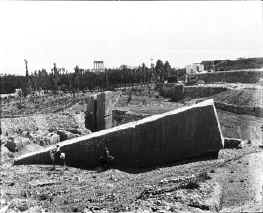
Courtesy:
www.gerty.ncl.ac.uk/photos/A_358.htm
"Phonecian block in
the quarry [Hajar el Hibla
"The Stone of the Pregnant Woman"
or the Stone of the South. European woman on horseback, probably
Gertrude Bell]"
www.gerty.ncl.ac.uk/letters/l435.htm
"Baalbek. Sun. June 3.[1900]..
The valleys, near the streams, are lined with the deepest thickest
vegetation, poplars vines and corn and every sort of fruit tree; the
villages well built, clean, prosperous -Gertrude
Bell Letters
www.gerty.ncl.ac.uk/letters/l436.htm
"Mon 4. ..at 9,
or so, we started off with a guide...We rode up
first to the quarries, the Phoenician quarries, where some of the great
blocks for the Temple of Baal are still lying, all hewn and ready and
never used." Gertrude Bell Letters
All around Hajar el Hibla are ancient burial places adding to the
interpretation as a place of death and revival.
|
Please click on images to enlarge
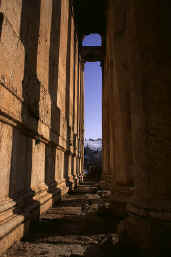
courtesy Christopher Willet.
www.pierce.ctc.edu/faculty/cwillett/
The solstice sun sets on the pillars of what is
generally known as the Roman temple of Bacchus.
It is now believed that this temple was
dedicated to Venus who was the Roman replacement for Astarte. |
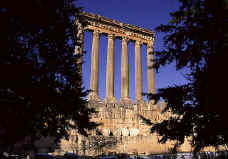
courtesy Christopher Willet.
The last remaining pillars of the
Roman temple of Jupiter
|
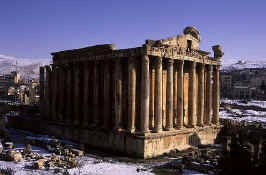
courtesy Christopher Willet.The
solstice sun sets on the pillars of what is generally known as the
Roman temple of Bacchus.
It is now believed that this temple was
dedicated to Venus who was the Roman replacement for Astarte.
|
|
At dawn on at the winter
Solstice with snow on the ground the sun rises from behind the Anti Lebanon
mountains which are also snow clad.
The sun shone and the winters
were cold with snow.
There is a huge investment
of man effort in this block of stone. It is an icon. An icon was
needed to bring the sun back.
In the Greek era BC
Baalbek was renamed Heliopolis.
The Hibla Stone is aligned to
be the pathway for the suns return to warm the water and the earth. And
then the grain grows.
|
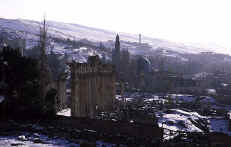
courtesy Christopher Willet.
This wonderful photo was taken
late in the afternoon of by Christopher Willett who visited
Baalbek on 22 December 2003. The setting sun is shining on the Anti Lebanon
mountains in the background. It is not yet warm enough to melt the snow
and bring growth back to the land.
It is particularly interesting to
me that Chris visited at the Solstice, or the shortest day when the sun
is lowest and the day shortest. |
|
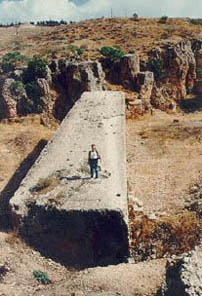
Courtesy: Ancient/ Historical Sites
http://www.lgic.org/en/photos2_baalbek.php
Hajar el Hibla is orientated towards
the rising solstice sun. It would be a pathway for the suns return. This
photo would have been taken at about midday.
This image shows the alignment of
the Hibla stone with the hill.
|
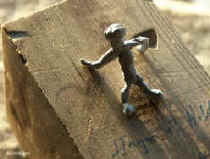
The impact of the sun
rising over the hill and the stone looking as if it were the pathway for
the return of the warmer weather must have been amazing .
To help visualize
it I made a wooden model of Hajar el HiblaI can imagine a priest climbing
the stone at dawn and asking the sun to come back and warm the
land.
The real stone is 14' across so my little Blue-Tack
man must be one of the race of Giants sometimes credited with moving
Hajar el Hibla's sibling stones up the hill to where they are now, part
of the foundations of the Roman Temple to Jupiter. |
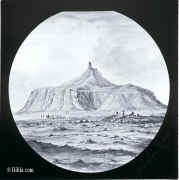
19th Century glass lantern slide
depicting "Ruins of Babylon". makers NEWTON 3 Fleet
Street
Norman Davidson writes
page 56: " At an early stage the Babylonians measured their
days from sunset to sunset, divided into twelve periods each called a 'beru'
and lasting about two hours. Later they divided the period from sunset
to sunrise into twelve equal parts."
In the summer daylight hours were
longer than daylight hours in winter.
It is hard to believe the
complexity of astronomical knowledge recorded in ancient times. But then
the very survival of the people depended on this knowledge
|
|
Hajar
el Hibla “the stone of the pregnant woman” is the largest cut stone
in the world.
I
think the “pregnant woman” is Mother Earth? Hajar el
Hibla may be not fully birthed child of the world? I have become
convinced that Hajar el Hibla is also one of the oldest ceremonial
astronomical instruments in the world.
I
was inspired to look at Hibla in this way by childhood visits to Newgrange
in the Boyne Valley in Ireland. See:
Hibla
is orientated towards the eastern sky. At about 8:30 to 9 in the morning the sun is aligned with the stone. Both sides are illuminated. This form
of illumination will only last a few minutes each day and be at the same
time. At all other times one or other side will be in shade. With such a
stone you have the ability to recognize a cycle in the sky. It is a
fixed plane and it is orientated to enable you to see the ecliptic as it
entered your horizon.
The upper
surface is angled so the sun of the winter solstice just shines along it
as it rises over the hill which is now called Sheikh Abdallah.
The stone would be a path to and from
the sun as it rises in the eastern sky at the winter solstice. Baalbek
can be very cold with snow upon the ground.
The
Romans Built their temple of Mercury , messenger of the sun on top of
the hill. Perhaps the return of the sun would be signaled to those
waiting below.
Ragette
tells us page 63 of " a monumental flight of stairs
cut out of the rock of the hill, 10 to 12 m (33'- 39') wide. Fragments
found in the vicinity included parts of engaged half columns and brief
inscriptions referring to Mercury, but the clues to the identification
of the temple are coins struck by Philip the Arab,
which show stately pseudo-peripteros on a mountain with a distinct
stairway leading up to it. Included in it is a caduceus insignia of
Mercury. "
I can almost see the people as they gathered in the snow. The tell
(settlement headquarters) is
up the hill about 1/2 mile and when they had completed their ritual here
at the stone perhaps they would proceed there.
This was the stone which was not
born and never should be. It was and is a monument in its own right for
any who have the eyes to look and see.
|
Please click on images to enlarge
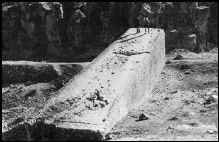
Courtesy: (Friedrich Ragette, Baalbek,
p114)
This photo was
taken mid morning. The shadows of the two figures are still long showing
that it is also early in the year. |
|
It is aptly named Hajar el Hibla: The stone of the pregnant woman. Is
the "pregnant woman mother earth?
Hibla has three siblings which are almost almost as big
which are the foundation on which the Romans built their largest temple
to Jupiter. It is a mystery how these huge stones were moved.
Perhaps the other stones were
floated up the hill on rafts when the land was flooded!
From the pictures I have
seen, there are several generations of man activity in the surrounding
stones. The Roman temple is buillt on the foundations of a far earlier
building.
"The Romans did it", the official story has lack of look. I
see nothing that would destabilize my life.
I
have tried to explore the way the sun rises on Hajar el Hibla using a model wooden model of
the Hajar el Hibla.
|
At the winter Solstice, a person standing at the top
of Hajar el Hibla will have either a shadow which is all along the stone or the upper
surface is totally in shade and the shadow of the person at the top of
the stone will be at the ground beneath.
I
have calculated the suns position using The Electric Astrolabe a fully
animated planetarium program in the form of a planispheric astrolabe.
see:
www.astrolabes.org/electric.htm
|
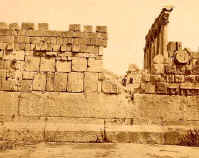
courtesy Bonfils, ca. 1870.
Bonfils was a French photographer working in Lebanon who created an
important visual record . This images shows part of the Baalbek
Trilithon..
The Trilithon is a series of three massive stones which are
almost as big as Hajar el Hibla. They were moved up the hill in pre
history and no one can say how! The Romans built their temple to Jupiter
on this earlier foundation. |
|
I have no doubt that the
solstice could be recognized by looking at how the sun lit the stone in
the morning.
Ritual would be used to emphasize the event. Perhaps the
priests and or priestesses clamed the credit for the suns return.
The
Hibla stone is truly huge. It
is 16’ by 16’ by 67’. Hajar
el Hibla has three sibling stones, which are almost as big, called the
Trilithon, which are part of the foundations of the largest temple the
Romans ever built. The official story that Hagar el Hibla is merely a
building block left behind in the quarry by the Romans, when they built
their temple complex, is in my view ridiculous.
The
Hibla stone is in the Beqa’a valley near Baalbek just south of the
largest temple complex the Romans ever built.
It is sometimes called Hajar el Gouble, stone of the south.
|
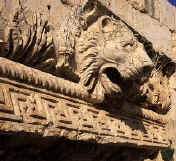
courtesy Christopher Willet.
This piece of the cornice of the Temple of Jupiter which lies on the
ground beneath where the Romans placed it. The Lions head reminding us
of the summer constellation of Leo. The Sun would have risen in Leo from
22 July approximately.
The lion head is flanked by deeply
carved palettes. He rests his head on on a twisted
bar. The whole cornice was the rain water gutter. Rather than using down pipes
as we do today the water poured dramatically from the lions mouth. |
|
Please click on images to enlarge
|
Baalbek
is at the roof of the world where two rivers , the Lîþânî and
Asi rivers. meet.
The place evokes
obvious symbolism. Water and earth with sun are the substance of life
and fertility.
This was an
ideal place of for human occupation. The rivers naturally irrigate the
valley. There is known evidence that there was human occupation over
6000 years ago. The climate
is bracing with cold winters including snow and warm summers.
Baalbek
is a place of obliterated history. At
one time it ranked as one of the biggest Roman cities in Syria. The
myths have been rewritten by the Greeks, the Romans, the Christians and
the Arabs. There is little
archaeological evidence to explain the origin of the site. There
has been little excavation. However, there is definite evidence of human
life back in the Early Bronze age (2900-2300 B.C) (Friedrich Ragette, Baalbek,
p16) This was found under the Great Court of the Roman Temple of
Jupiter.
|
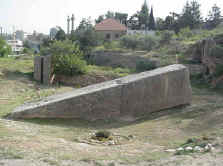
Courtesy:
tracyanddale.50megs.com/baalbeck
/stone.html
"On the way to the temple
complex, one can stop at the Hajar El-Hubla, claimed by many (especially
here in Baalbeck) to be the largest hewn block of stone in the world. It
still rests here in this quarry which the was source of much of the
stone for the temples. It is 21.3 meters of crystalline limestone. It
certainly rivals the obelisk of Hatshepsut at Karnak Egypt in size. Its
scale also raises the same question that confronts Egyptologists in
respect to the Pyramids: how did the Phoenicians transport these huge
stones? Nobody seems to know for certain. There is also a legend
associated with the stone. It seems an infertile woman spent the night
on the stone and woke to discover the next day that she was with child.
Since that time locals refer to it as "the stone of the Pregnant
Woman."
www.tracyanddale.50megs.com/baalbeck
/baalbeck1.html
Tracy and Dale have a wealth of
pictures on their site, including panoramic views of the Roman and Arab
ruins.
See
also: http://en.wikipedia.org/ |
|
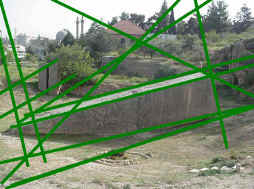
Tracy and Dale's picture of Hajar
el Hibla with projection lines:
It would appear that the photograph was
taken in the early morning The light pattern is very similar to the
Gertrude Bell picture indicating that the photo was also taken early in
the morning. The scene has changed quite a lot since the visit
by Bell in 1900. The domed roof of a mosque can be in the
mid ground, |
|
The
Greek history (and written history) in the Baalbek only begins in the 4th
Century BC. They
renamed Baalbek, Heliopolis – City of the Sun. This is believed to
have been in the Seleucid period (after 198 BC). To differentiate this
Heliopolis from Heliopolis in Lower Egypt, writers used to refer
to it as Heliopolis in Phoenicia or Lebanon
The
Roman temple complex was built upon an earlier foundation.
(Ragette records a bronze age tell beneath the temple to Jupiter) There is no written history so
we are left with only the evidence of our eyes. The date of the foundations
is at best guesswork.
There are modern tests which could be
done, like examining the crystallization of the stone surfaces, so long
as no one has restored and cleaned them up first!
|
Please click on images to enlarge
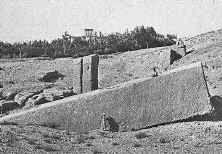
Courtesy Bonfils, ca. 1870.
Courtesy: http://www.biblemysteries.com/library/baalbek.htm
I think this is one of the oldest pictures of the Hajar El Hibla
and that it was taken at the end of the 19th century was taken at the end
of the 19th Century by Bonfils. |
|
Hajar
el Hibla has three sibling stones which are almost as big. They are part
of the visible foundation of the Roman temple to Jupiter. They are
called the Trilithon. No one has given convincing evidence as to how
these incredibly large and heavy stones were moved from the quarry. I
find Ragette’s belief that it was the Romans wholly unpersuasive and
accept the holes put in Ragette’s thesis by Andrew Collins.
|
Andrew
Collins, has published a two part essay on the web
in which he rejects
the argument that the Romans were responsible for Baalbek. He examines
the myths and refers to folklore accounts from both Egypt and Palestine
where “there are tantalizing accounts of how sound, used in
association with `magic words', was able to lift and move large stone
blocks and statues, or open huge stone doors.” He speculates that
“Baalbek's first `city' was constructed, not just as a religious
centre, but also as an impenetrable fortress against attacks by whatever
we see as constituting the gigantes and Titans of mythology?”
|
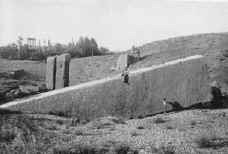
Courtesy Bonfils, ca. 1870.
See also further great pictures of the Baalbek stones
 |
|
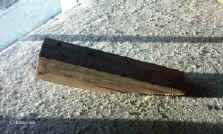
My wooden model of Hajar el
Hibla aligned with the rising sun at the winter solstice. As I am in
London Latitude 51 32 N and Baalbek is at 34 N the sun in my
sky was much lower. The upper side of the stone is in total darkness |
.
|
I
don’t think it’s possible to separate myth from science from fact.
They all help to discern the true facts. Once we reject the official
view that it was the Romans who moved
Hajar el Hibla’s sibling stones up the hill to where they are
now the foundation of the largest temple to Jupiter they had ever built,
we are in “don’t know territory”.
It is all guesswork. We do not know the technology; we do not
know the when, or the who, and we do not know the why. It is all
speculation. The confidence with which Ragette credits the Romans for
moving the Trilithon is scary and misleading.
|
Please click on images to enlarge
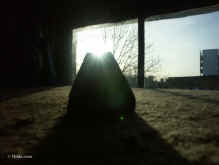
My wooden model of Hajar el
Hibla aligned with the rising sun at the winter solstice. As I am in
London Latitude 51 32 N and Baalbek is at 34 N the sun in my
sky was much lower. The upper side of the stone is in total darkness.
The block totally eclipses the rising sun. |
|
Michael
Alouf, who was the curator of the runes History
of Baalbek writes:
“Baalbek
is considered as one of the most ancient cities of the world. All
nations, particularly the Arabs who took possession of it suppose that
it dates from time immemorial. According to their legends Adam and the
Patriarchs inhabited the country round Baalbek…” Alouf goes on to
report a Maronite tradition: “the fortress of Baalbek on Mt Lebanon is
the most ancient building in the world. Cain, the son of Adam built it
in the year 133 of the creation, during a fit of raving madness. He gave
it the name of his son Enoch and peopled it with giants who were
punished for their iniquities by the flood.”
|
Man
has little surviving written history. What we have tells little of the
story as to how we have got to here. Most of the story is speculation
not fact.
When bits are written down there are sometimes references to
planet knowledge and seasons which could not exist if the authors did
not have access to a lot more than we are reading.
The inhabitants of
Baalbek were without doubt successful farmers.
|
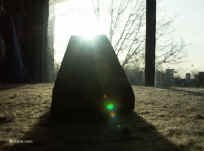
|
The
buildings they built leave a record of the knowledge which is as clear
as writing. And Hajar el Hibla is a building.
No
one in modern times seems to have realized that Hajar el Hibla needed to be interpreted.
The archeologists’ attention was always diverted by the surviving
Roman structures with their decoration rather than this simple icon of
the understanding of time.
The sun is asked to return and warm the
frozen land.
|
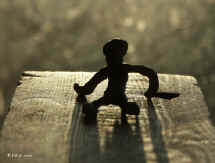
My wooden model of Hajar el
Hibla aligned with the rising sun at the winter solstice. As I am in
London Latitude 51 32 N and Baalbek is at 34 N the sun in my
sky was much lower. The upper side of the stone is no longer total
darkness. The shadow of the crawling figure is the full length of
the stone.
To get this image I tilted the
stone so as to align with the sun . I wanted to imagine the impact
on people watching the dawn.
|
Please click on images to enlarge
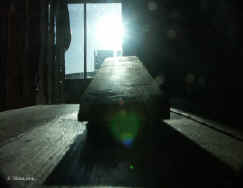
My wooden model of Hajar el
Hibla aligned with the midday sun at the winter solstice. As I am in
London Latitude 51 32 N and Baalbek is at 34 N the sun in my
sky was much lower. The upper side of the stone is no longer total
darkness.
|
Also
in Baalbek we are not in a land of freedom of speech. We are in a place
which to survive obliterates history. So do most places (even now!).
Ragnett records the charter issued by Abu Obaida in A.D 637. The
inhabitants were offered three possibilities: leave, adopt Islam. Or pay
a special tax. Before them The Christians had destroyed much.
|
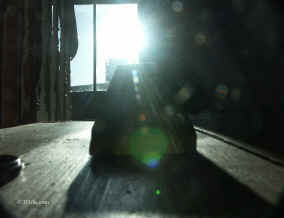
My wooden model of Hajar el
Hibla aligned with the Midday sun at the winter solstice. As I am in
London Latitude 51 32 N and Baalbek is at 34 N the sun in my
sky was much lower. The upper side of the stone is total
darkness.My wooden model of Hajar el Hibla aligned with the Midday
sun at the winter solstice. As I am in London Latitude 51 32 N and
Baalbek is at 34 N the sun in my sky was much lower. |
|
The
Catholic Encyclopedia
Puts
the Christian history thus, with no sign of regret:
“The
introduction of Christianity
into Baalbek is obscure. In the life of St. Eudocia, there is mention of
one Theodotus, Bishop of Heliopolis, in the reign (117-138) of Hadrian. (Acta
SS., 1 March, 8f.) The account is of doubtful historical value and when
Constantine forbade the licentious pagan practices, there were no Christians
there. Constantine, however, erected a church or perhaps simply
transformed one of the temples into a Christian
basilica, which he entrusted to a bishop with priests and deacons
(Eusebius, Life of Const., III, lviii). During the reign of Julian
(361-363) the Christians
were severely persecuted (Sozomen, History, V, x). Paganism disappeared
from Baalbek only after Theodosius (379-395) had destroyed the idols and
probably the Great Temple."
This
is an abuse of others beliefs and their expression in art.
|
Please click on images to enlarge
How
can we be surprised that there is no written history. There are even periods
when we would expect official record when there was none.
Has this amazing
stone survived by being "just a building block.
|
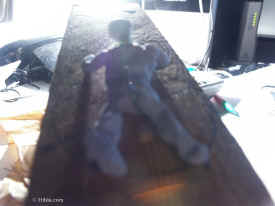
My wooden model of Hajar el
Hibla aligned with with my desk lamp My Blu-tak man is way
too big! |
|
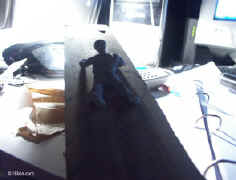
My wooden model of Hajar el
Hibla aligned with with my desk lamp My Blu-tack man is way
too big!
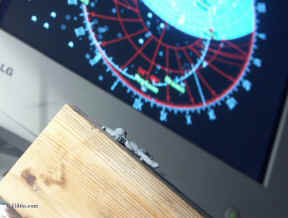
My wooden model of Hajar el
Hibla aligned with with my desk lamp: my Blu-tack man is way
too big!
The Electric Astrolabe is running
on my computer.
|
|
Hajar
el Hibla is an Astro Temple
Ancient
agrarian communities, or in plain language “people who husbanded
there animals and grew their crops”, farmers, needed
to recognize the seasonal changes that followed the sun cycle. A simple
calendar just using the very visible cycles of the moon and having
twelve lunar months in a year will not work for long. It does divide
time in humanly recognizable periods. The phases of the moon may be
important for plant growth, but the length of day which is controlled by
the sun, certainly is. Some plants will only flower when the days are
less than 12 hours or we have past the summer equinox.
Hibla
would have given a reference point for the moon too. It is an unmoving
plain to which to refer the movement of the heavens
It
is a sort of fixed telescope.
|
Please click on images to enlarge
Perhaps
with the wonders of the internet there is someone local who can take
some pictures at particular times. Is there anyone in Baalbek reading
this?
I
will have to go there and look for myself.
Baalbek
was a special place. And Hajar el Hibla is a very special stone.
|
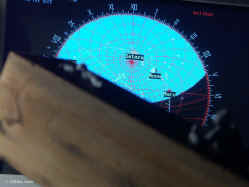
|
Appendix 1
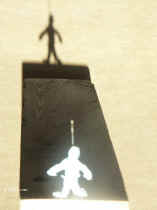
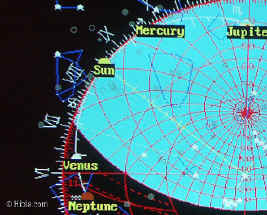
Detail: The Electric Astrolabe
shows the sky at 8:30 in the morning in Baalbek at the solstice 2005.
The "morning star" is Mercury Jupiter is at the Midheaven and
occupies the place the sun will be at midday. The twin bright
stars of the constellation of the Goat, now because of the precession of
the equinoxes in the sign of Sagittarius.
We can see from Babylonian records
that ancient astronomers were fully capable of recognizing and
recording detailed astronomical facts. Some of their records have
survived.
|
I
have tried to explore the way Hajar el Hibla would be illuminated with pictures
illuminated by the sun on a model wooden model..
At the winter Solstice, a person standing at the top
will have either a shadow which is all along the stone or the upper
surface is totally in shade and the shadow of the person at the top of
the stone will be at the ground beneath.
In any case, I have no doubt that the
solstice could be recognized by looking at how the sun lit the stone in
the morning. Ritual would be used to emphasize the event. Perhaps the
priests and or priestesses clamed the credit for the suns return. In
this picture the sun is aligned with top of the model of the stone. The
shadow cast by the person is on the ground at the other end of the
stone.
If
my information as to the exact position of Hagar el Hibla is not right
the very theatrical images could have been achieved if the figure stood
on a small platform
These
very strong images
In
any event the stone would have provided a reference point against which
to compare the sun rise each day. The fact that it was left connected to
the bedrock emphasizes this.
In
this picture the rays of the sun are just below.
In the next as the sun is only a few degrees higher
the figure leaves a shadow all along the 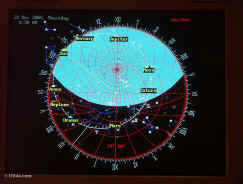
The Electric Astrolabe shows the
sky at 8:30 in the morning in Baalbek at the solstice 2005.stone.

|
Select Bibliography, further information and
photos
SOME BOOKS Alouf
Michael M., History of Baalbek ,
First published in 1890, This edition 1999 The Book Tree Escondido.
CA. ISBN 1585090638 Davidson,
Norman. Astronomy and the Imagination, a new approach to mans
experience of the stars , Routledge &
Keegan Paul Ltd, London . ISBN 710203713, ISBN
710201179, ISBN 14019078-3 O'Kelly,
Michael J, and Claire O'Kelly, Newgrange -
Archaeology, Art and Legend , Thames & Hudson London,
1982. ISBN 500390150 Ragette Friedrich, Baalbek,
Chatto & Windus, London, 1980, ISBN 701121467. WEBOGRAPHY CURRENT
THEORIES ON OUR FORGOTTEN PAST http://www.geocities.com/seqenenretaoii/theories.html
This website revolves around the search for a lost race
that left their fingerprints all across the world and includes a section on
Baalbek.
Mystic Places
http://www.world-mysteries.com/mpl_5.htm
Jonathan Gray
http://www.world-mysteries.com/mpl_5b1.htm
Alan F. Alford writes in depth on The Mystery of the Stones at Baalbek
. He offers some modern photographs taken when he visited in May 1995. W.T.
Wallington, a retired carpenter with 35 years experience in construction
in his The Forgotten Technology official website http://www.theforgottentechnology.com/
speculates on how to move heavy stones. He makes it look so easy! The Hibla
stone is bigger but some of the demonstrated stone moves are impressive. Gordon
Pipes records how he moves heavy stones with leavers and refutes the traditional
archeologists' explanation of ramps and huge manpower. He moves a block weighing
much less than the Hadjar el Hibla. http://www.stonehengetheanswer.com/
I found the attempt to get under the skin of ancient building techniques enthralling. Daniel
Da Cruz tells the story of Baalbek's traumatic history
http://www.saudiaramcoworld.com/issue/196702/phoenix.of.the.plain.htm
The Lebanese Ministry of tourism have published many pictures of
Baalbek the links are below. http://www.saudiaramcoworld.com/issue/196702/phoenix.of.the.plain.htm http://www.traveladventures.org/continents/asia/baalbek.shtm
Personal travel impressions in text and pictures from Baalbek, Lebanon. Click on
the pictures to enlarge, send as a free e-card, or download for personal use. http://www.shoofimafi.com/2004_pics-beq.cfm?RequestTimeout=500 http://www.fiu.edu/~rquin001/lebanon2.html http://members.tripod.com/hew_frank/id27.htm http://www.araboo.com/
a wealth of information about the Arab world: Araboo.com
is a premier Arab World directory, with categorized links to Arabic sites,
updates, resources and more. http://www.galenfrysinger.com/baalbek.htm http://www.pacal.de/baalbek.htm http://www.beiruttimes.com/photos/ http://earth.leeds.ac.uk/leb/sites/baalbek.htm http://www.myphotographs.net/lebanon/image1.html http://www.myphotographs.net/lebanon/lebanon.html http://www.myphotographs.net/lebanon/image2.html http://www.sacredsites.com/middle_east/lebanon/baalbek.htm http://www.ceticismoaberto.com/fortianismo/jgarrido_baalbek.htm http://www.yanabi.com/activeweb.cfm?a_id=718 http://www.bearfabrique.org/Catastrophism/Baalbek/Baalbek.html http://historic-cities.huji.ac.il/lebanon/baalbek/baalbek.html http://www.opuslibani.org.lb/photolebanon/fbaalbek.htm http://www.poutnik.cz/asie/libanon/mistopis/zs-baalbek/ http://users.stlcc.edu/mfuller/Baalbek.html http://weekly.ahram.org.eg/2000/468/re1.htm http://www.phil.uni-erlangen.de/~p1altar/photo_html/topographie/syrien/baalbek/balbek6.html http://www.wyattnewsletters.com/babel/sum35.htm http://www.travelblog.org/Photos/94963.html http://www.unesco.no/kultur/verdensarven/kriterier.html http://intercosmos.iespana.es/reportajes/ciencia/baalbek.htm http://photos.eisenbach.at/voyages/lebanon/7.htm http://www.baalbek.org/Column%20With%20Contents.htm http://www.onhiatus.com/journal/journal.cgi/670-685F.html http://www.conspiracynewsnet.com/shadow.html http://perso.wanadoo.fr/terres.bibliques/liban_tb/baalbek/baalbek.htm http://www.erkareisen.de/libanon01.html http://www.cedarseed.com/water/antiquity.html http://www.tu-cottbus.de/BTU/Fak2/Vermwes/
map http://www.upf.edu/materials/fhuma/portal_geos/tag/t2/img/2.18baalbek.JPG http://www.cs.utk.edu/~langston/Pix/Lebanon-Pix/bekaa-valley/tn/temple-of-jupiter.jpg.html http://www.syjoho.nl/photo_albums/200206/
http://www.syjoho.nl/photo_albums/200206/images/02%20Baalbek23%20(Lebanon)_jpg.jpg http://www.biblelandstudios.com/nuke/modules.php?name=News&file=article&sid=60 http://www.zenobia-studienreisen.de/B_13__Tag_Baalbek.113.0.html http://www.shechem.org/machon/schwarz/palestine/lebanon.html http://www.stefaniemoehrle.de/Libanon/Libanon.htm http://www.dm.net.lb/freeguide/tour/tour1.htm http://www.tufs.ac.jp/common/fs/asw/ara/senkou.html http://www.pbase.com/little_sis/image/19903571 http://tabisite.com/gallery_as/lebanon.html http://homepage.mac.com/drysdale/Pages/Mount_Lebanon.html http://www.discoverlebanon.com/photo_gallery.php?photoid=125
picture of hibla http://library.wustl.edu/units/spec/archives/guides/bysubject_stlouis/sturgis-link-photos/box120rmembaalek.jpg http://www.aaronfollett.com/archives/2005/05/
includes drawing of Ottoman Fortification, Baalbek, Lebanon http://www.satellitediscoveries.com/articles/greatest/secret.html http://geo.ya.com/travelimages/lebanon.html http://www.brynmawr.edu/Admins/DMVRC/lanterns/lrgimage/lebanon/LX000239.html
Temple of Bacchus, Detail of doorway, with keystone raised photo pre 1914:
original Bryn Mawr number: 193; new number: 239 http://www.brynmawr.edu/Admins/DMVRC/lanterns/lrgimage/lebanon/LX000858.html http://www.si.umich.edu/chico/kelsey/KS_9/KS_95.6.html
Date: January 14, 1920
Photographer:
George R. Swain Caption: A typical small Arab village. Baalbek
to Damascus http://www.si.umich.edu/chico/kelsey/baalbek.html
Francis W. Kelsey and the Near East
Expedition of 1919-192Images of
Baalbek, Syria http://www.speleogenesis.info/archive/publication.php?Type=publication&PubID=3269 http://www.cdr.gov.lb/sdatl/4/Figure_IV_13_L_agglom_ration_de_Baalbek_enjeux_de.htm
map: Figure IV.13. L’agglomération de Baalbek, enjeux de développement
de la zone urbaine. http://www.dainst.org/index_586_de.html
Deutsches Archäologisches Institut one of the finds described as: Gewandbesatz
aus Blattgold: Garb trimming from gold foil: The image looks like a
cross between Heliopolitan Jupiter / baal-Sun and the Roman lion that was used
in the capitol decoration of the temple. http://www.dainst.org/index_2951_de.html http://herve.jezequel1.free.fr/piruinorient.html http://www.kahlil.org/lebanonpics2.html
Photographs of the Lebanese
Scenery
http://intercosmos.iespana.es/reportajes/ciencia/baalbek.htm
Erich von Daeniken RECUERDOS DEL FUTURO
http://herve.jezequel1.free.fr/piruinorient.html
http://www.southcoast.net/gregb/baalbek.html
http://www.um.u-tokyo.ac.jp/publish_db/Bulletin/no01/no01004.html
object was the discovery of cave sites:These were areas as the northern part of
Bekka Valley, main ridge of the Lebanon Mountains.
http://www.ancientx.com/nm/anmviewer.asp?a=35&z=1
early morning photo of hibla!
http://durigon.alien.de/baal.htm
Horst und Anke Dunkel give a clear history of the ancient
ruins , Die Tempel von Baalbek:"Wohnsitz der Götter"
http://www.medinaarts.com/JHLCat08.htm
(View the lithographs of
Baalbec.)
http://www.katolik.nu/libanon/libanon_40002.htm
several pictures of Hibla.
http://aboulhiss.tripod.com/id21.htm
My country Lebanon.
http://www.marsanomalyresearch.com/evidence-reports/2005/088/part-2/strange-colossi-2.htm
|
bb |
Please click on images to enlarge
|
|
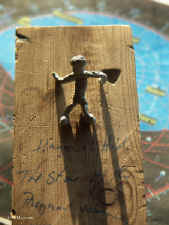
climbing to the sun
|
Please click on images to enlarge
Please click on images to enlarge
Please click on images to enlarge
|
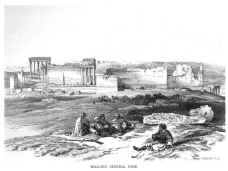
DAVID ROBERTS
Tinted lithographs from the quarto edition of his famous work
"The Holy Land, Syria, Idumea, Arabia, Egypt & Nubia",
published in London by Day & Son, 1855-56.
|
Please click on images to enlarge
|
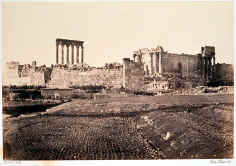
Baalbek Ruins by Francis Frith
|
Please click on images to enlarge
|
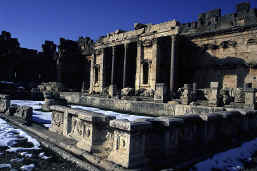
courtesy Christopher Willet.
|
P
lease click on images to enlarge
|
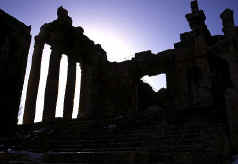
courtesy Christopher Willet.
The Winter Solstice sets behind the Roman temples at Baalbek leaving the
world to stars and planets which in the clear dark sky would have been
very visible.
|
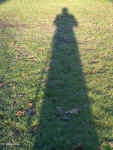
My shadow cast by the setting sun on the grass of London Fields
at the solstice this year.
|
|
All text and images and linked images are ©
1999-2006 Joseph O'Kelly.If you require any further
information on permitted use, or a licence to republish any material, email us
at copyright@hibla.com
|